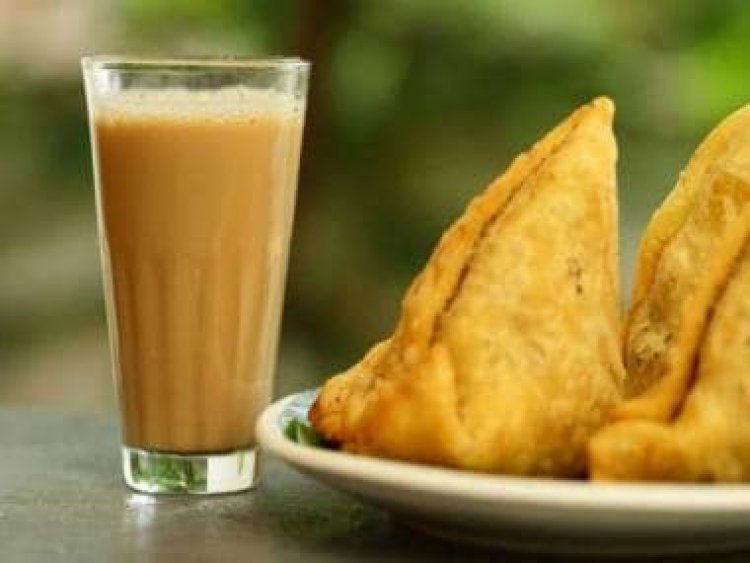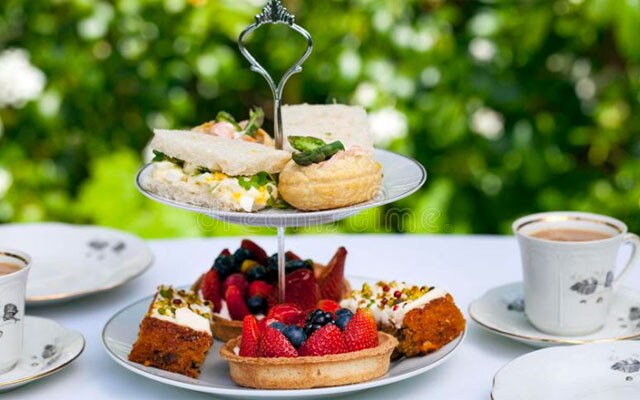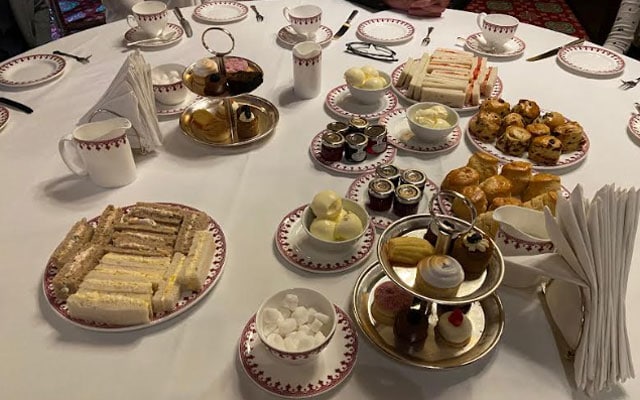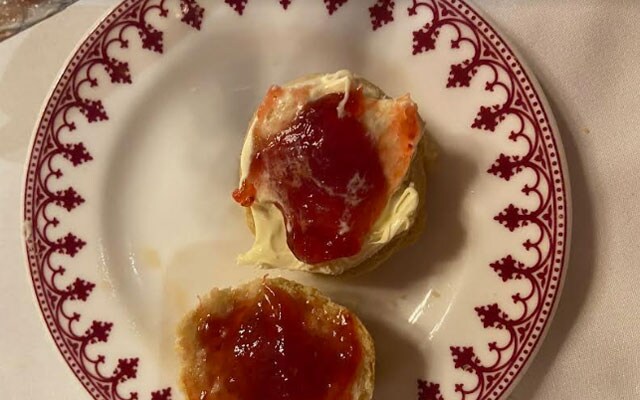Food Friday | Our love affair with afternoon tea
Food Friday | Our love affair with afternoon tea

This summer, while vacationing in London, I had the privilege of being invited for high tea at the House of Lords Peers’ Dining Room. Our group consisting of children as young as six and seniors as old as 80, were scuttled through many security barriers and brought to the stately environs of the dining area in this hallowed building. Meant exclusively for the use of peers of the parliament, this room is decorated with plush carpeting and rich interiors. It, therefore, was the perfect setting for the decadent afternoon tea served to us. After requesting our beverage of choice – varying types of teas of course – our immaculate servers brought out tiered cake trays bedecked with the best of sweets and savouries. We were spoilt for choice with egg-mayo, tuna tartare, and cheese-tomato sandwiches; hot scones served with dollops of clotted cream and jams made in-house; as well as a plethora of biscuits, pastries and cakes. “Nothing quite beats the pleasure of afternoon tea!” exclaimed our generous host, Charles James Dugdale, 2nd Baron Crathorne, echoing the sentiments of all present.

Having studied in London, I have enjoyed the custom of traditional English afternoon tea many a time. I fondly recall visiting the iconic Brown’s Hotel in Mayfair, which boasts one of the oldest afternoon tea services in London, as well as more modern variations around the city. I’ve also experienced it amidst the beautiful Yorkshire countryside at the Crathorne Hall Hotel, when it was served to us in the property’s resplendent garden. The concept of afternoon tea appeals to people both as a ritual and a feast. It offers a sampling of luxurious decadence without breaking the bank, and the hour at which it is served, allows one to indulge in excess without feeling too unhealthy.

On this occasion, as I soaked in the regal history of my surroundings, I reflected on the nature of this age-old tradition. Tea was first discovered in China around 2750 BC. It became popular as it was accredited with many medicinal properties. For thousands of years, both in China and India, it was consumed as a bitter concoction of boiled tea leaves. By the time it came to be consumed for pleasure, trade as the basis for colonisation was well-established. The Dutch were the first to drink tea in Europe, and Britons were introduced to it around 1650. As an expensive imported beverage, however, the drinking of tea was limited to the upper echelons of society. Enterprising traders were keen to explore more affordable ways to procure this loved beverage and attempted to plant Chinese tea saplings in India. Fortunately, in 1824, tea saplings were discovered in Assam by Robert Bruce and Maniram Dewan, which led to the expansion of tea plantations across Assam and Darjeeling. Before long, Indian tea had overtaken its Chinese counterpart on the European market.
Then, around 1840, the Duchess of Bedford who was a Lady in Waiting to Queen Victoria, invented the English afternoon tea service as we know it. As she felt peckish between meals, she ordered a pot of tea and a light snack of bread with butter and cake to her room. Having thoroughly savoured this afternoon delight, she began inviting her friends, the high society ladies of England, to join her in this ritual. The trend caught on as other ladies followed suit, using it as a means of showcasing their hospitality, manners, and fashionable homes.

In India, tea had not yet caught the imagination of most Indians or become such an innate part of our culture. That happened with concerted marketing efforts in the early 1900s. Following the international economic depression, the exports of tea traders suffered immensely, which made them change focus to the domestic market. Initially, they targeted middle and upper-class Indians to replace their European babus. As the value of tea continued to drop, however, they widened their net to increase tea consumption across the country, regardless of class, race, gender, or region of origin. Before long, tea was everywhere. Salespeople promoting it could be found on train stations, factories, villages and cities. They offered public demonstrations on the art of brewing tea and handed out free sample cups or single-use packets to take home.
In a modern context, drinking chai has become more than a soothing ritual. It is now seen as an affiliation that marks one’s social status, tastes and preferences. Homemaker Sujata Goel says, “Whether you drink it in an earthen kulhad, slurp it through a saucer, or clink your fanciest China cups; whether you boil it in milk, have it flavoured and iced or in its purest form as black tea – the style and preference of consumption may differ in many ways, but there is no denying that everyone drinks tea.”
This matriarch presides over a household of 25 odd people, consisting of three generations and a retinue of hired help to cater to everyone’s needs. The septuagenarian adds, “Though my husband has passed on, I have two sons, daughters-in-law, a daughter married nearby who visits often, and five grandchildren of varying ages. Everyone has packed schedules and we barely get to see each other, but we have a firm family tradition we follow. Every Friday, come what may, we all meet for afternoon tea at 5 PM in my drawing room. I have a variety of snacks made, and we sit and chat about our lives over cups of steaming tea. Later the help also drink their tea with the leftovers, so as not to waste food.”
Goel’s household is one of many that practices similar bonding rituals, across the length and breadth of India. Just as with the elaborate afternoon tea service in England, Indian chai is often accompanied with savoury and sweet treats, which include a judicious mix of Indian and western snacks. Fluffy cucumber and chicken sandwiches, delightful pakoras, crunchy namkeens, crumbly biscuits and guilt-inducing barfis and other mithais are some examples.

Though primarily started as a domestic ritual, in the last century it became an important social one and entered the public sphere as well. To this day, it is fostered in its traditional sense by the strong ‘club’ culture that still exists in most metro cities of India. Every hotel worth its salt offers a tea service. Mostly, however these are served buffet style, in a departure from a traditional English afternoon tea service.
Tea afficionados look down their noses on ‘chai’ as it is popularly construed in India. Noted food critic Vir Sanghvi points to the Indian habit of ‘cooking’ tea with lots of milk and adding sugar to disguise its actual taste. “The tea itself is no longer the point of the exercise!” he writes. Perhaps that itself captures the true meaning of what tea means to us as a race. Drinking tea, particularly in the afternoon, is a ritual that transcends cultural and other social boundaries. A Gujarati loves chai as much as Punjabis or Hyderabadis; and eighty-plus grandparents relish it with as much pleasure as their teenaged grandchildren. For this, and its numerous other benefits, this love affair with afternoon tea is definitely one for the ages.
Noor Anand Chawla is an independent writer who writes on lifestyle for various publications and blogs at www.nooranandchawla.com.
Read all the Latest News, Trending News, Cricket News, Bollywood News, India News and Entertainment News here. Follow us on Facebook, Twitter and Instagram.
What's Your Reaction?



























































